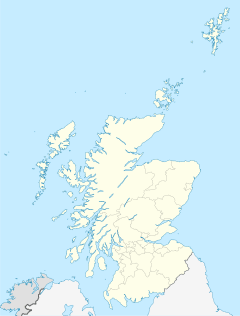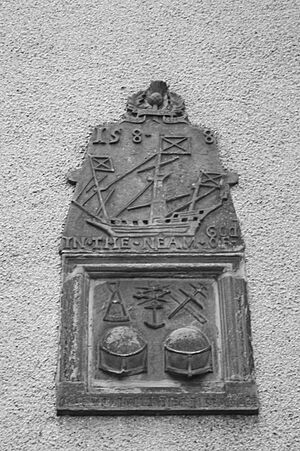Trinity, Edinburgh facts for kids
Quick facts for kids Trinity
|
|
|---|---|
 Trinity Park House, now demolished |
|
| OS grid reference | NT248765 |
| Council area |
|
| Country | Scotland |
| Sovereign state | United Kingdom |
| Post town | EDINBURGH |
| Postcode district | EH5 |
| Dialling code | 0131 |
| Ambulance | Scottish |
| EU Parliament | Scotland |
| UK Parliament | |
| Scottish Parliament | |
Trinity is a lovely neighborhood located in northern Edinburgh, Scotland. It used to be part of the nearby town of Leith until 1920, when it became part of Edinburgh. Trinity is famous for its large, beautiful houses, many of which were built in the 1800s. It's surrounded by other areas like Wardie, Newhaven, Victoria Park, and Bangholm.
Contents
How Trinity Got Its Name
The name Trinity comes from a place called Trinity House in Leith. This group used to own a lot of land here, including a big farm called Trinity Mains. You can still see a special stone plaque with the farm's coat of arms on a building on Newhaven Main Street today.
Even though some buildings in Trinity are from the 1700s, most of the area was built in the early 1800s. It became a popular place for wealthy families to have big mansion houses. Many rich people from Edinburgh's New Town even had "second homes" here, treating Trinity as a peaceful "country retreat."
Today, the houses in Trinity are a mix of different styles. This is because people have always wanted to live here, so new buildings have been added over the years. Victoria Park is a great green space in the area. There are also many cycle paths and walkways that used to be old railway lines, perfect for exploring!
Interesting Buildings in Trinity
Wardie Castle and Boswall Road Homes
A small part of the old Wardie Castle, built way back in the 1400s, can still be seen on Wardie House Lane. It was rebuilt in 1780 by Sir Alexander Boswall, who gave his name to Boswall Road.
Some of the houses on Boswall Road, specifically numbers 17 to 23, were built in 1815. The house on the far west side even had a special area for looking at the harbor with a telescope! The middle and east parts were once a school called the Pollock Missionary School.
Challenger Lodge and St Columba's Hospice
One of the most famous buildings on Boswall Road was Wardie Lodge. It was later renamed Challenger Lodge by Sir John Murray in 1914. He named it after his amazing Challenger Expedition, which explored deep parts of the ocean. After being a children's home, it became St Columba's Hospice in 1977, a place that provides care for people who are very ill. The original lodge is still there, but it's now part of the larger modern hospice buildings.
Another old house, 11 Boswall Road, called East Cottage, dates back to the 1600s. It was a summer home for a famous writer and professor named Professor John Wilson, who also used the pen name "Christopher North."
Trinity Chain Pier and Railway Station
From 1821 to 1898, the Trinity Chain Pier was a busy place. People used it for ferries and later for swimming. The building where you bought tickets for the pier is still there today and is now a pub! The old Trinity railway station is also nearby, converted into homes.
Local Churches and Schools
Wardie Parish Church is one of the Church of Scotland churches you can find in Trinity.
Trinity Academy is a well-known school in the area. It was built in 1894 and was originally called Craighall Road Public School. It's one of Edinburgh's older schools, but it has big, modern additions on its east side.
Trinity Cottage, which was once the home of a famous businessman named Christian Salvesen, was taken down in 1969. New offices for the National Health Service (NHS) were built there. These offices were then taken down in 2008, and new townhouses were built instead. Only the old wall and a small building called the south lodge remain from the original Trinity Cottage.
Famous People Who Lived in Trinity
Trinity has been home to several interesting people over the years:
- Allan Ker VC (1883-1958) lived at a place called St Abbs on Russell Place. He was awarded the Victoria Cross, a very brave award.
- James McBain FRSE (1807-1879) was a surgeon in the Royal Navy and a naturalist, someone who studies nature. He spent his last years in Trinity.
- Dr James Russell FRSE (1754-1836) was a surgeon who lived at Bangholm Bower House.
- John Wilson FRSE (1877-1959) was an architect who lived at 20 Lomond Road.
Images for kids






